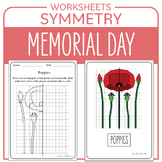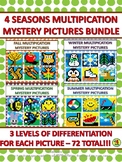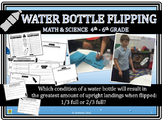45 results
High school geometry laboratory microsofts
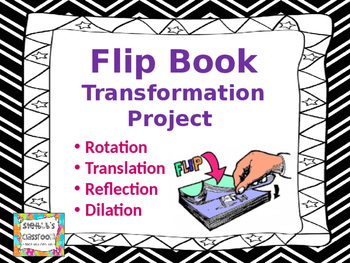
Flip Book Transformation Project
Students create a flip book using Power Point to discover and/or apply properties of geometric transformations. The student handout provides detailed instructions on how to create the flip book which includes using the “duplicate slide” feature in Power Point. Students are required* to create a minimum of 10 slides with 4 different movements. Students are given the opportunity to choose what type of movements they use within given parameters. This choice provides the opportunity for great di
Grades:
7th - 10th
Types:
Also included in: Transformations Bundle
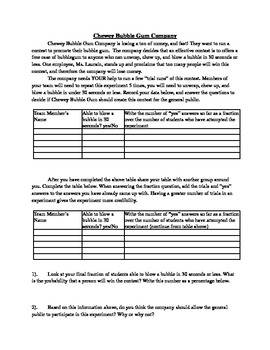
Chewey Bubble Gum Company - Intro To Probability
Want to introduce your students to the probability of something happening? Want to peak their interest before you start a probability unit? This experiment based activity allows students to find the probability of something happening while having fun and popping bubble gum bubbles!
Subjects:
Grades:
6th - 12th

Clinometer Discovery Lab (Using Trigonometry)
I gave this project to both geometry and PreCalculus students. I gave them specific directions (included) on how to make a clinometer, but taught them nothing else about how to use them. They had to figure out how to use trigonometry to find the height of some objects in our commons (on a nice day, it would be awesome to go outside). Students used a lot of trial and error, and found how important it was to have an accurate diagram. I checked in frequently with each group-common errors included n
Subjects:
Grades:
8th - 12th
Types:
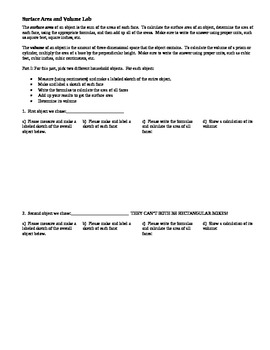
Surface Area and Volume lab (Editable)
I've taught my students the formulas for the surface areas and volumes of prisms, cylinders, and cones for a long time, and yet when they are asked to apply these formulas to everyday objects (cereal boxes, soup cans, printer cartridge packages, etc.), they seem to see the formulas as alien pieces of information.
I created this hands-on lab to help them with these concepts in a physical, hands-on way. This is a challenging activity for my students, sometimes because I find a few students who d
Grades:
9th - 11th
Types:
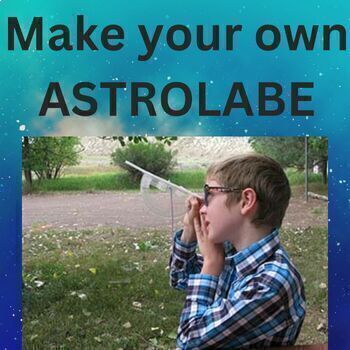
Astronomy Astrolabe Lab Middle School Science
Essential QuestionHow did early astronomers measure the stars and planets?Combine Math and science in your classroomI begin this lab by asking students who is the most important on a Pirate ship. They tell me it is the Captain and inform them that is the wrong answer. The navigator is because he knows your location and where the buried treasure is located.MaterialsPlastic protractor with a holeLarge plastic straw12-inch piece of stringSmall bolt or washer (or other metal weight that can be tie
Subjects:
Grades:
8th - 10th
Types:
NGSS:
MS-ESS1-3
Also included in: Astronomy light, planets sizes , space rocket and sun tracking
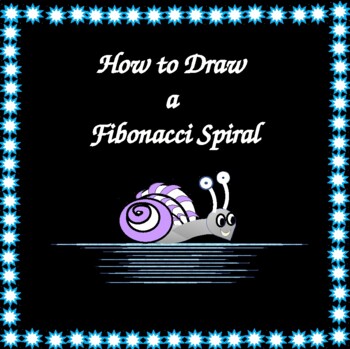
Math Lab How to Draw a Fibonacci Spiral and DISTANCE LEARNING/NO PREP
I am absolutely excited to share the following Math Lab that teaches students how to draw a Fibonacci Spiral!* This lab is an outstanding way to open any lesson or unit on sequences!* Leonardo Fibonacci is introduced and it is explained to students how the sequence got its name.* Students are given examples of the Fibonacci Sequence as it appears in nature and in architecture.* A list of materials required to complete this lab is provided in the lab.* Students follow well-defined steps to
Grades:
5th - 12th, Higher Education, Adult Education
Types:
Also included in: BUNDLE: Draw the Fibonacci Spiral, Fibonacci in Nature, Golden Ratio
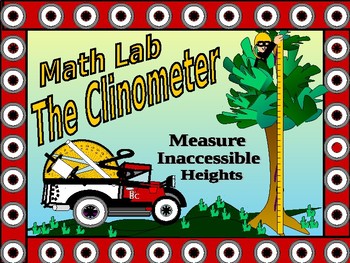
Math Lab: The Tangent Ratio, a Clinometer, and Inaccessible Heights
The following math lab is a follow-up to lessons on the Trigonometric Ratios:* In the lab, students follow steps to create a measuring device called The Clinometer* Students use the Clinometer to measure objects of inaccessible heights such as trees or flag poles.* To measure the objects, students use their Clinometer and apply the Tangent Ratio.* Students work with a partner. * One partner looks through the Clinometer while the other partner records the data required to calculate the tange
Subjects:
Grades:
7th - 11th, Higher Education, Adult Education
Types:
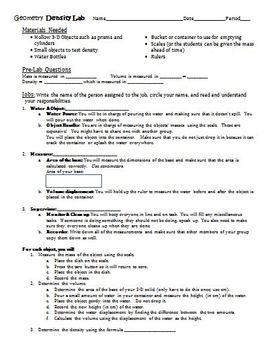
Geometry Density Lab
CCSS.MATH.CONTENT.HSG.MG.A.2Apply concepts of density based on area and volume in modeling situations. The students will perform a lab where they have to calculate volume using water displacement and then find the density of irregular objects such as rocks, marbles, etc. The lab will be outlined with pre-lab questions, job descriptions so students can decide in their groups who will cover which tasks, places for students to show their work, and a section for reflection including peer evaluation
Grades:
9th - 12th
Types:
CCSS:

Polygon Interior Angle Sum Theorem Investigation
Students are given 4 polygons and asked to divide them into triangles. They then find the interior angle sum by multiplying the number of triangles by 180. The students will use their findings to derive the formula for the sum of the angles in any polygon.
Grades:
7th - 12th
Types:

Geometry Lab for Start of School - Measuring Line Segments with Candy and Rulers
Looking for a new way to start off the year teaching Geometry? For a change of pace, rather than read the rules to the kids on the first day I decided to give them this activity instead.
Supplies Needed: Notecards, paperclips, Starbursts, rulers,
This is essentially a printable/editable packet with 6 different line segments that the students will measure using 6 different units of measurement. I chose 3 non-traditional units (notecard, paperclip, Starburst) and traditional units (Inches,
Subjects:
Grades:
5th - 11th
Types:

Surface Area & Volume of Oblique Prisms: Student Investigation
In this investigation, students will use raw spaghetti and mini marshmallows to discover how the surface area and volume of a prism relate to the surface area and volume of the respective oblique prism. Students will be asked to create a rectangular prism using marshmallows to connect the vertices. Using a ruler, they will measure the dimensions of the prism, calculate and record the surface area and volume. Then they will make their prism into an OBLIQUE prism by giving it a slight push to t
Subjects:
Grades:
6th - 10th
Types:
CCSS:
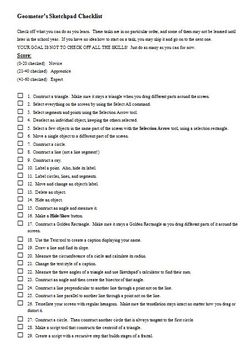
Geometer's Sketchpad Checklist (Editable)
After taking my Geometry students to the computer lab to show them how to use Geometer's Sketchpad for about the third time, I realized that they were learning a lot more about the program by just playing around with it, and by trying to get it to do things I hadn't thought of, so I changed my focus the fourth year and thereafter.
Instead of giving them a step-by-step list of instructions (which inevitably failed, since students would click the wrong thing at some point and end up in a place wh
Grades:
9th - 11th
Types:
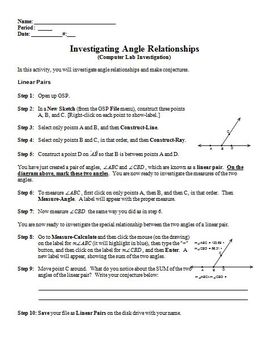
Geometer's Sketchpad: Investigating Angle Relationships (Editable)
This is an activity for Geometer's Sketchpad. Students investigate linear pairs, vertical angles, slopes of lines, slopes of parallel lines, corresponding angles, alternate interior angles, and alternate exterior angles.
The activity "holds their hands" through the steps, and it is assumed students have a familiarity with GSP software.
Keywords: Jonnard
Grades:
9th - 11th
Types:
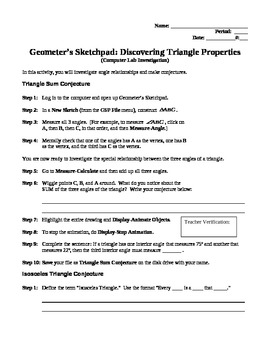
Geometers Sketchpad - Discovering Triangle Properties (Editable)
I like to use Geometer's Sketchpad to help students "discover" the Triangle Sum Conjecture (the sum of the interior angles of a triangle is 180 degrees); the Isosceles Triangle Conjecture (that the base angles of an isosceles triangle are congruent); and the side-angle inequality conjecture (that the largest side is opposite the largest angle, the smallest is opposite the smallest, etc.). I have included "teacher verification" steps so that students must call you over when they have discovered
Grades:
9th - 11th
Types:
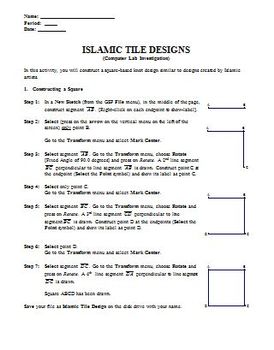
Geometer's Sketchpad: Islamic Tile Designs (Editable)
This is an activity for Geometer's Sketchpad. Students create Islamic Tile Designs, so named because they portray geometric designs.
The activity "holds their hands" through the steps, and it is assumed students have a familiarity with GSP software.
Please download the pdf preview file first, so you can see exactly what's included; the product file is a word document, which you may personalize for your students.
Keywords: Jonnard
Grades:
9th - 11th
Types:
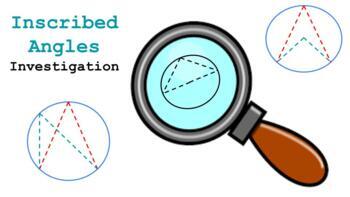
Inscribed Angles Investigation
In this activity students will explore the following theorems and corollaries:The measure of an inscribed angle is equal to half the measure of its intercepted arc.If two inscribed angles intercept the same arc, then the angles are congruent.If a quadrilateral is inscribed in a circle, then its opposite angles are supplementary.The measure of an angle formed by a chord and a tangent is equal to half the measure of the intercepted arc.Students should use Geogebra, Desmos, Geometer's Sketchpad, or
Grades:
9th - 10th
Types:

Geogebra Investigation Geometry Angle Type (Alternate Ext, Alternate Int, etc.)
Use Geogebra to help your students get a better understanding of angle relationships, line properties, and angle types (alternate exterior, alternate interior, consecutive interior, corresponding)
Grades:
9th - 11th
Types:
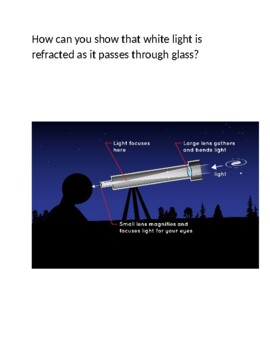
Astronomy Telescope Refraction of light
STEM This lesson contains 2 quick labs for students to understand the basic principle of optical astronomy. This fun lesson begins with aq discussion of visible light. The properties of refraction are defined. Then plications of these properties are applied to describe how refracting telescopes operate. There is a math problem to illustrate the importance of finding the radius of a circle.Worksheet and answer key are included.MS-PS4-2Develop and use a model to describe that waves are reflect
Subjects:
Grades:
7th - 9th
Types:
NGSS:
MS-PS4-2
Also included in: Astronomy light, planets sizes , space rocket and sun tracking
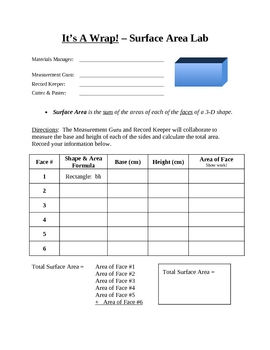
Surface Area Lab
This surface area lab helps students understand how we find the surface area of rectangular prisms.
Subjects:
Grades:
4th - 11th
Types:
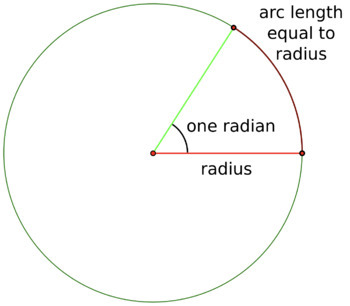
Physics Laboratory Activity: The Radian WITH SOLUTIONS
The editable laboratory activity will give students hands-on experience to see the relationship between radians and degrees of a circle. Physics and math students alike will enjoy this fun and engaging activity while they examine the concept of the radian. Solutions are included!
Subjects:
Grades:
8th - 12th
Types:
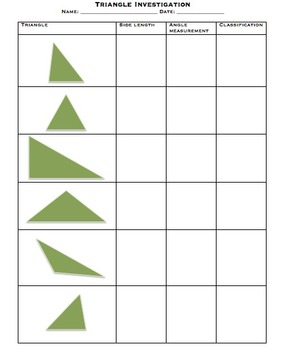
Triangle Investigation
This is handout/worksheet/table that could be done in groups, partners, or a whole group setting. Students will measure angles and sides to discover how triangles are classified. You can teach them the 6 different types of triangles before or after. This investigation is good for a math inquiry lesson.
*Because I upload my items as word documents, the formatting changes. If you are not able to fix this, please let me know, and I can provide a pdf version of the file.
Subjects:
Grades:
5th - 10th
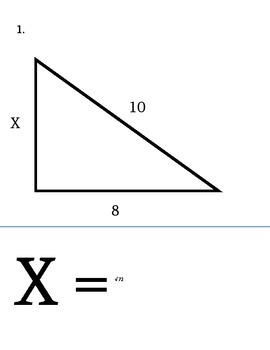
Pythagorean Theorem Activity, Stations, Geometry, Scavenger Hunt
Instructions
Possible Uses:
• Mid-lesson or End of Lesson Check for understanding
• Math Stations (Middle School students like it this way)
• Test Review
• Homework Alternative Bell Work
• Bell Work
Directions for instructor:
This activity is designed to help students work problem with Pythagorean Theorem using algebra and it gets students up and about. Place the 14 cards on the wall around your room. Students pick any card to begin with. They write an equation, then solve for x. Next, the s
Grades:
6th - 10th
Types:
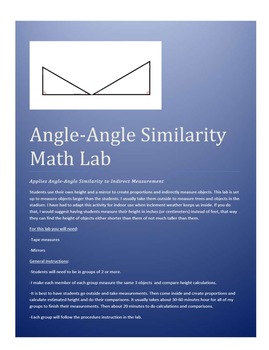
Angle-Angle Similarity Lab
This lab uses angle-angle similarity to indirectly measure objects. By Function Junction.
Subjects:
Grades:
8th - 11th
Types:
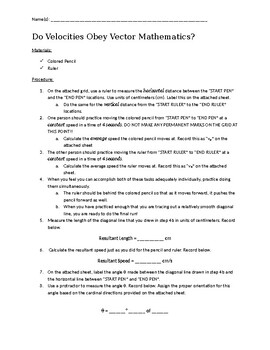
Do Velocities Obey Vector Mathematics?
This is an activity that allows students to experimentally see that perpendicular velocities will combine to create a larger overall velocity. The activity allows for comparison of experimental results to mathematical results obtained using the tip-to-tail method along with Pythagorean theorem and tangent function. It is a means of making mathematics interactive.
Grades:
9th - 12th
Types:
Showing 1-24 of 45 results

